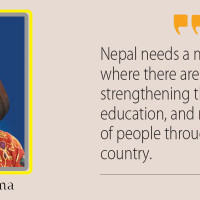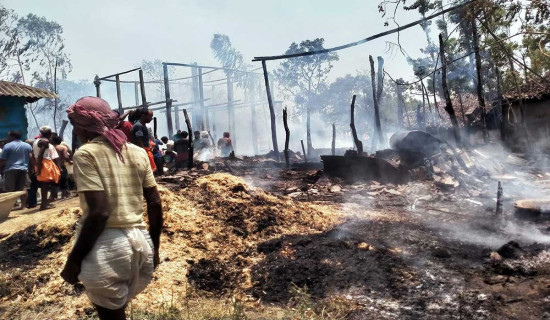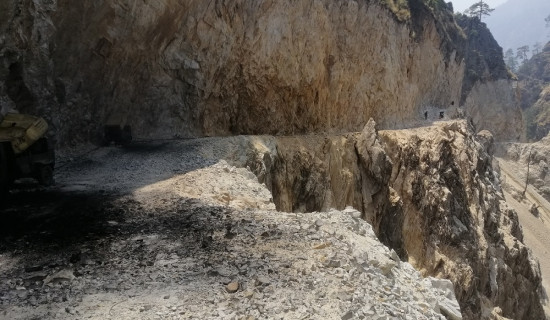- Wednesday, 1 May 2024
Shore Up Adaptive Social Protection
Improving people’s living conditions and creating a resilient society is a daunting task. Lifting Nepal’s 20.27 per cent people, who are currently below the national poverty line, out of poverty demands a mixture of serious policy and programmatic interventions. Despite some official claims of poverty reduction and improvement in living standards, mutually reinforcing cycle of chronic poverty, economic inequality, social marginalisation and frequent shocks have been making our livelihoods fragile and vulnerable. As shocks due to climate change, rising food prices, pandemic and conflict increase in frequency and intensity, large number of households are affected and unable to cope, recover, and rebuild their livelihoods.
As poverty and vulnerability become more pronounced as does hunger and malnutrition. This makes it difficult to tackling these new shocks becomes more and more challenging. As these problems mature, solution towards creating a resilient society become tougher and increasingly costly. The popular adage ‘prevention is better than cure’ applies here too. Various research studies have demonstrated that stronger social protection system linked with scaled-up adaptive social security programmes is a critical piece of building a resilient country. Such system can prevent poverty-related problems and resolve them before they become unsolvable. As people fall farther below that poverty line, lifting them out of poverty becomes very difficult.
Social contract
In such context, social protection will also help to reinforce the social contract, tackle the root causes of poverty, prevent people from falling into poverty, fragility and vulnerability. Hence, government, development partners and other development actors should recognise the need for an Adaptive Social Protection (ASP) system as a basis for enhancing sustained national prosperity. It has been argued that ASP helps build the resilience of poor and vulnerable households by investing in their capacity to prepare for, cope with, and adapt to shocks, ensuring that they do not fall (deeper) into poverty. Nepal currently hosts about 87 fragmented social protection schemes, but most of them are not adaptive to emerging shocks and risks.
It has been argued that making social protection more flexible and agile to such crises allows for more effective and efficient long-term resilience building. The COVID-19 pandemic has clearly demonstrated the need for a more strengthened and robust ASP. Massive cash transfer programme was the historic good example of adaptive social protection practiced in the US during the COVID-19 pandemic. In Nepal, building upon the existing uncoordinated social protection system, there is a need to make the system more responsive to shocks and other emerging crises. This entails to prioritise investments in human capital, which stand to drive economic inclusion, foster social cohesion and combat the cycle of poverty, vulnerability and fragility.
Indeed, ASP can be a fundamental instrument to promote resilience as it has the power to prevent people from falling down into poverty. From this perspective, it is a myth to consider social protection expenditures as unproductive expenses. This fiscal year marks a breakthrough in the history of social protection in Nepal. The cabinet has approved the Integrated National Social Protection Framework, 2080. This framework was envisioned nearly a decade ago. A committee was constituted at the National Planning Commission to craft a draft back in 2076 B.S., following the decision of the National Development Action Committee chaired by the Prime Minister. It should be noted here that only very important developmental issues are discussed in this committee.
This is also a clear evidence of government’s leadership in such critical issues. The main objective of this framework is to integrate the fragmented social protection schemes implemented by federal, provincial and local governments. It has also acknowledged the importance of ASP schemes. Recognising that the expansion of ASP relies on the coming together of social protection, disaster risk management, climate change and other forms of crises that bring poverty and vulnerability in peoples’ livelihoods, this national framework provides a big picture for the efficient and effective design and management of social protection schemes.
The framework adds shock-responsive component in Nepal’s existing social protection system. It recognises the fact that various shocks distort people’s lives. Hence, accurate and timely social protection is required to heal such shocks. Food security, nutrition and poverty reduction priorities must be tackled in tandem with ASP to overcome vulnerability and falling down of people livelihoods. There is a need to carry of a through diagnostics of existing social protection schemes assessing the adaptability, convergence, merger, coherence and scalability potential of existing fractured schemes.
Inadequate coverage
There is also a need to strengthen vital registration and social registry system to facilitate the extension of social protection coverage, improved selection of beneficiaries, and a more streamlined social protection response across difference agencies and levels of government. The crux is to invest, including in the form of domestic resources and beneficiary contributions, and in the coverage expansion of national social protection schemes with robust adaptive dimensions. The coverage is just around 33 per cent of the population. And coverage is clearly inadequate to satisfy basic needs. The national framework can a useful conceptual guideline towards this.
The refined social protection system should help poor and vulnerable households adapt to the impacts of climate change and socio-economic shocks. It should also strengthen national social protection system to deliver cash transfers to vulnerable households immediately prevent and tackle shocks. Government and other partners can utilise their relative strength and do partnerships in such delivery while ensuring government leadership. Going forward, if sustained poverty reduction has to be realised in Nepal, we must ensure that national adaptive social protection system is developed and gradually scaled up to support poor and vulnerable people. This will create synergy for developing a more resilient, cohesive and prosperous Nepal.
(Dr. Bhusal is an expert in poverty, employment and social protection.)















